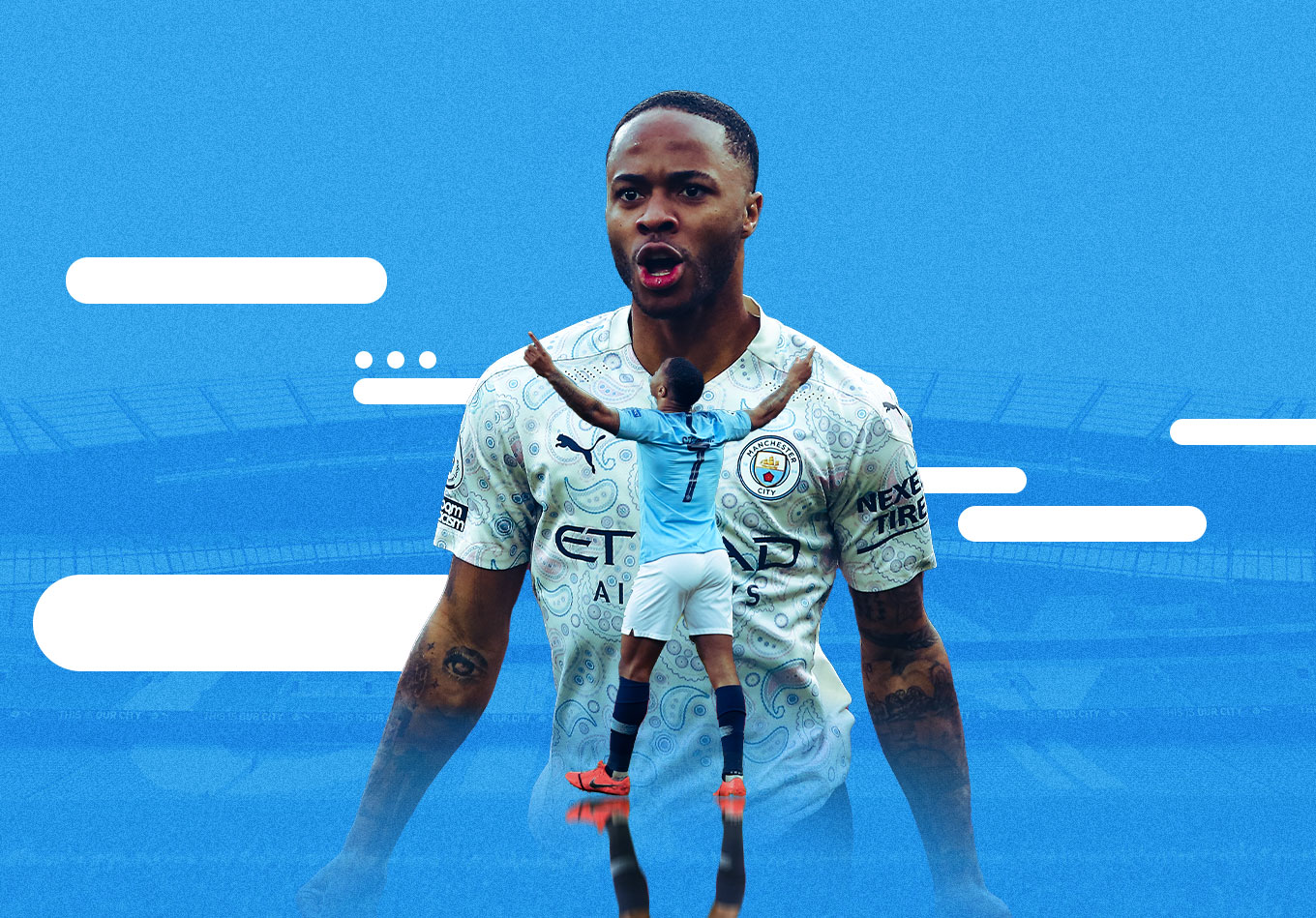Nine years on from his debut in the competition, Raheem Sterling is on course to become one of the Premier League greats according to the data.
Kevin De Bruyne’s scintillating long-range strike against Borussia Monchengladbach last week was Manchester City’s 100th goal of the season and maintained Pep Guardiola’s record of his sides reaching a century in each of his 12 seasons in top-flight coaching.
At Barcelona, Bayern Munich and now at Manchester City, Guardiola the tactician is loath to go on the defensive. However, whenever he feels the quality or worth of one of his players might have been called into question during a news conference, that position is second nature.
“He’s an incredibly important player for us,” the Catalan snapped back unequivocally when Raheem Sterling’s declining output in front of goal was raised this year, two days after he put a penalty against Brighton and Hove Albion into orbit to prolong a lean spell of three goals in 18 games.
“Everything we have done in the past, without him would not have been possible.“
Quite simply, that is a whole lot of everything.
Under Guardiola, City have won six major honours. They became the first team to reach the 100-points landmark when lifting the Premier League in 2017-18 and retained the title as part of an unprecedented domestic treble the following season.
A 14-point lead at the top of the table and next month’s dates in the EFL Cup final and FA Cup semi-finals mean a clean sweep in England is once again a possibility as Borussia Dortmund await in the last eight of the Champions League.
One of the points of difference this time around is Guardiola’s apparently assertion the past couple of weeks that more of the success he craves might be possible with Sterling confined to the margins.
After being defended by his manager in January, Sterling embarked upon a run of six goals in nine games across all competitions, including one in a deeply cathartic 4-1 win over former club Liverpool at Anfield and concluding with an early winner at Arsenal in February.
He has not added to a 13-goal haul in 2020-21 since and after wasting two glorious late chances in the 2-0 derby defeat to Manchester United, Sterling was an unused substitute for the subsequent 5-2 win over Southampton.
That decision apparently prompted a row denied by both men – “nothing happened” said Guardiola, “FALSE” tweeted Sterling – after the England international was omitted from the travelling squad for a 3-0 win at Fulham.
It means, as Wednesday marked the ninth anniversary of the 26-year-old’s top-flight debut, that one of the most impressive Premier League careers of the past decade has encountered some unusual on-field turbulence.
Chasing Shearer and Rooney
Aside from a tempestuous end to his final season at Liverpool as Sterling sought to leave and a patchy start at City as Manuel Pellegrini’s tenure spluttered to an end, the winger’s trajectory has aimed relentlessly upwards since Kenny Dalglish introduced him as a substitute against Wigan Athletic on March 24, 2012, aged 17 years and 107 days.
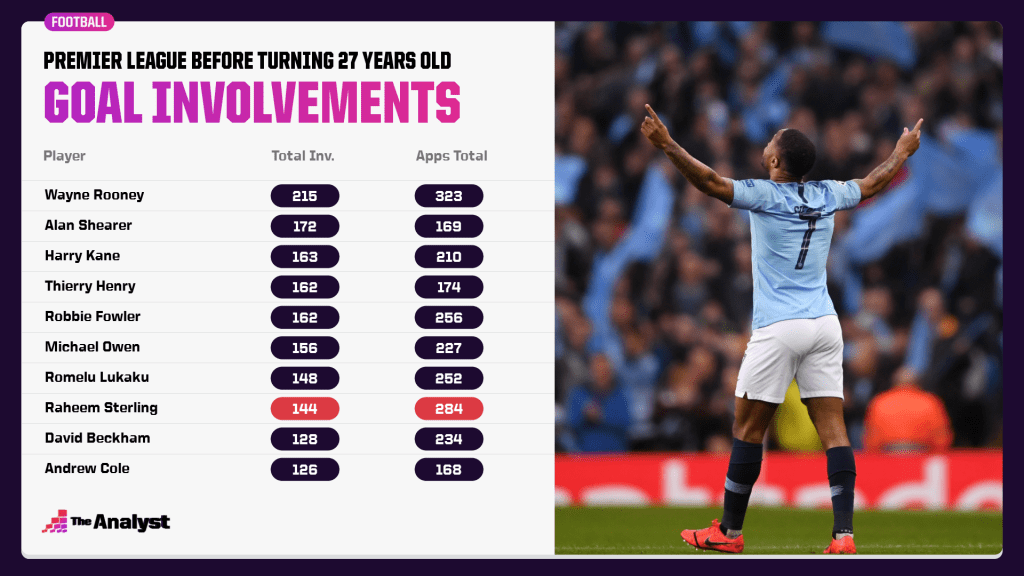
He has 144 direct goal involvements in 284 Premier League games, with 95 goals and 49 assists. Ranking all players in Premier League history before their 27th birthdays, this puts Sterling eighth – one place above David Beckham (128 goal involvements).
Wayne Rooney leads the way (215) from Alan Shearer (172), Harry Kane (163), Thierry Henry, Robbie Fowler (both 162), Michael Owen (156) and Romelu Lukaku (148), meaning a few of that esteemed group are within reach for Sterling before he turns 27 on December 8.
Overall, Shearer remains king, his all-time record haul of 260 Premier League goals among 325 goal involvements, ahead of Rooney on 311 (208 goals, 103 assists).
By all accounts, Sterling should be entering his peak years and is fractionally ahead of Liverpool duo Mohamed Salah and Sadio Mane (92 and 91 respectively) in the race to become the 30th member of the Premier League’s 100 goals club.
Along with having the chance to join Rooney and Frank Lampard as the third dual goals and assists centurion in league history, Sterling’s overall output means he will get close to Shearer and Rooney’s levels if he can maintain it.
All of which makes Sterling’s absence from a certain conversation fairly curious.
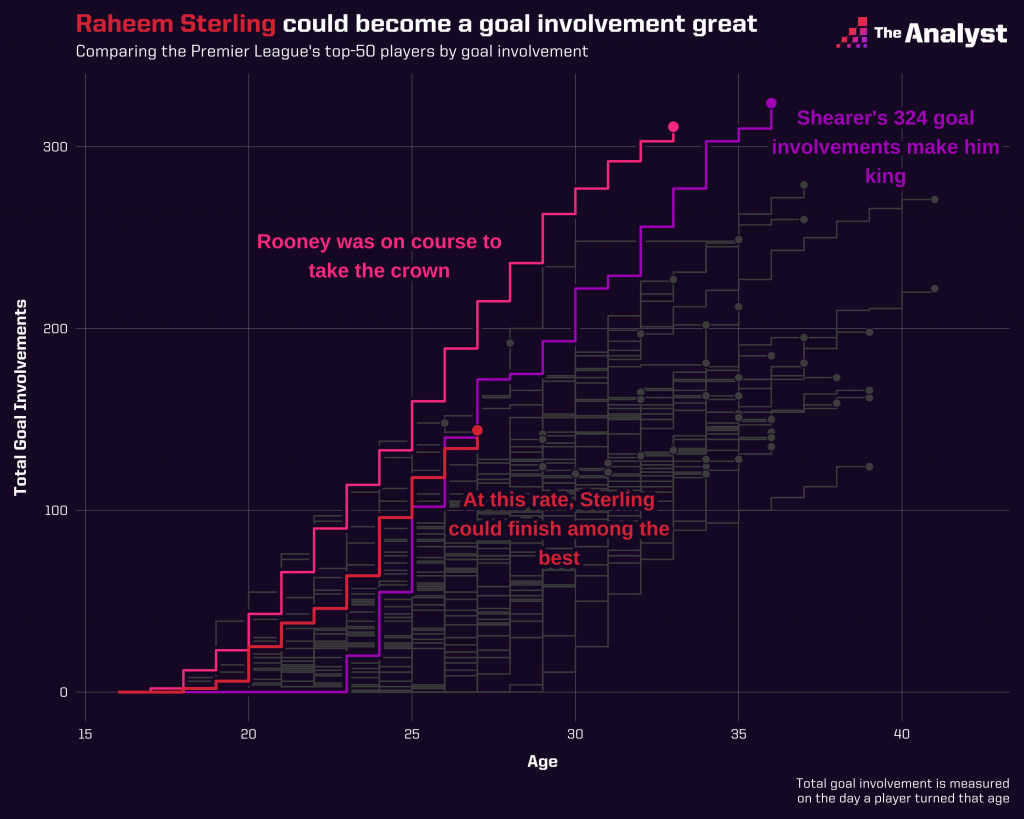
From #TheHatedOne to Premier League Great?
In recent years, Manchester City bade fond farewells to the first batch of superstars that propelled the club’s transformation from also-rans to trophy collectors.
When they departed, Yaya Toure, Vincent Kompany and David Silva were all acclaimed as being among the very best in their positions to grace the division. Similar talk will accompany Sergio Aguero if, as looks increasingly likely, he leaves the Etihad Stadium when his contract expires in June.
De Bruyne is very much in the midst of his prime years, having joined City in the same 2015 close-season as Sterling, and is already spoken of in such terms.
But the notion of Raheem Sterling: Premier League great? Despite the numbers outlined above, it is a consideration seldom made.
This can be partly attributed to the vitriolic reaction that followed his Liverpool exit, which embedded poisonous and unfair perceptions of an ambitious young footballer.
Sterling was infamously dubbed “footie Idiot Raheem” in an article by The Sun following England’s Euro 2016 exit against Iceland, where the City player won a penalty in a 2-1 defeat.
Earlier in the tournament, he labelled himself “#TheHatedOne” on social media. The vibrant performer from his Liverpool days began to return on the field under Guardiola, but the attitude from the terraces made it feel like Sterling had a point.
At grounds such as Turf Moor, the Hawthorns and the King Power Stadium, he was booed, despite no obvious rivalry existing between City and their opponents. For many there was grimly familiar discomfort and unease at what was happening.
Then, at Stamford Bridge in December 2018, Sterling was targeted by a group of home supporters, their faces contorted in anger. The incident led Chelsea to banning a fan for life for using “racially abusive language”.
The day after the match, Sterling addressed the unequal media coverage given to black and white footballers in a social media post, and what this means to those on the receiving end. He remains a powerful voice in the fight against racism in football and society as a whole.
Sterling’s status as a role model and an inspiration played a part alongside his phenomenal performances for treble-winning City as he was named 2018-19 FWA Footballer of the Year.
The surrounding and frequently vile noise accompanying his career in England is not something shared by Sterling’s City counterparts. The stand he took after the Chelsea match will remain a defining time in his career and, in terms of performance analysis, it might be seen as the moment where all other noise faded into the background and a rare talent was given his due.
There is, however, another elephant in the room when it comes to assessing Sterling’s elite credentials. Or, more accurately, an elephant in the six-yard box.
Floored by Missed Sitters
The 2019-20 season was the most prolific of Sterling’s career as he scored 31 times overall and hit 20 in the Premier League.
Nevertheless, it concluded with him somehow blazing over from four yards with City 2-1 down to Lyon in the quarter-finals of the Champions League. The Ligue 1 club soon led 3-1 and City were out – a nadir of the Guardiola era.
For a player who scores so frequently, Sterling’s finishing remains maddeningly unreliable at times.
During City’s 100-point season, Guardiola hauled him off after an implausible miss at Burnley and a couple of botched clear openings in that April Manchester derby, where City led 2-0 and lost 3-2, were a huge factor in the ultimate bragging rights of claiming a league title with victory over their bitter rivals going begging.
Then, despite contributing tirelessly to the collective effort, Sterling failed to score as England reached the semi-finals of the 2018 World Cup. It is impossible to imagine Rooney or Shearer doing likewise in similar circumstances, making that campaign an unhelpful anomaly in any pretentions to greatness.
So, is Sterling’s finishing overall as bad as those forgettable moments suggest?
Since his debut, he is the fifth-highest scoring Premier League player on 95, behind Aguero (164), Harry Kane (159), Jamie Vardy (115) and Lukaku (113).
A shot conversion rate of 15.9% tracks below that quartet, with Vardy the most efficient at 22.2% and Lukaku closest to Sterling on 16.7%.
Of the 31 players to have scored 50 or more Premier League goals during that time, Sterling ranks around the middle of the pack, 15th overall in terms of shot conversion – Christian Benteke’s tragicomic figure of 8.7% conversion bring up the rear.
In terms of those defined by Opta as ‘big chances’, Sterling falls into the bottom third of the group in 22nd, having netted 66 and missed 83 over the course of his top-flight career (44.3%).
This is perhaps what you’d expect from a man with a reputation for missing his share of high-profile sitters, but improvements over recent seasons show why he is still able to be on the trajectory of Shearer and Rooney for goal involvements.
The bulk of Sterling’s Premier League goals came over the most recent three completed campaigns, with 18 in the 100-point season backed up by 17 to retain the title and 20 last time around – comfortably his three most prolific goalscoring seasons.
Each time, his shot conversion was above 20%, with a high of 22 in 2018-19. The only other time he finished so efficiently was when scoring nine times from 45 attempts during Liverpool’s surprise 2013-14 title tilt.
There has been a drop off this time around, with nine goals from 53 attempts amounting to a 17% conversion rate, while he has missed two thirds of the big chances on offer (6/18).
On that metric, he tracked as high as 60% in 2018-19, having registered 53.8% the season before – both success rates to rival any elite forward. Despite the overall strong returns of 2019-20, his big chance conversion rate dipped to 42.4%.
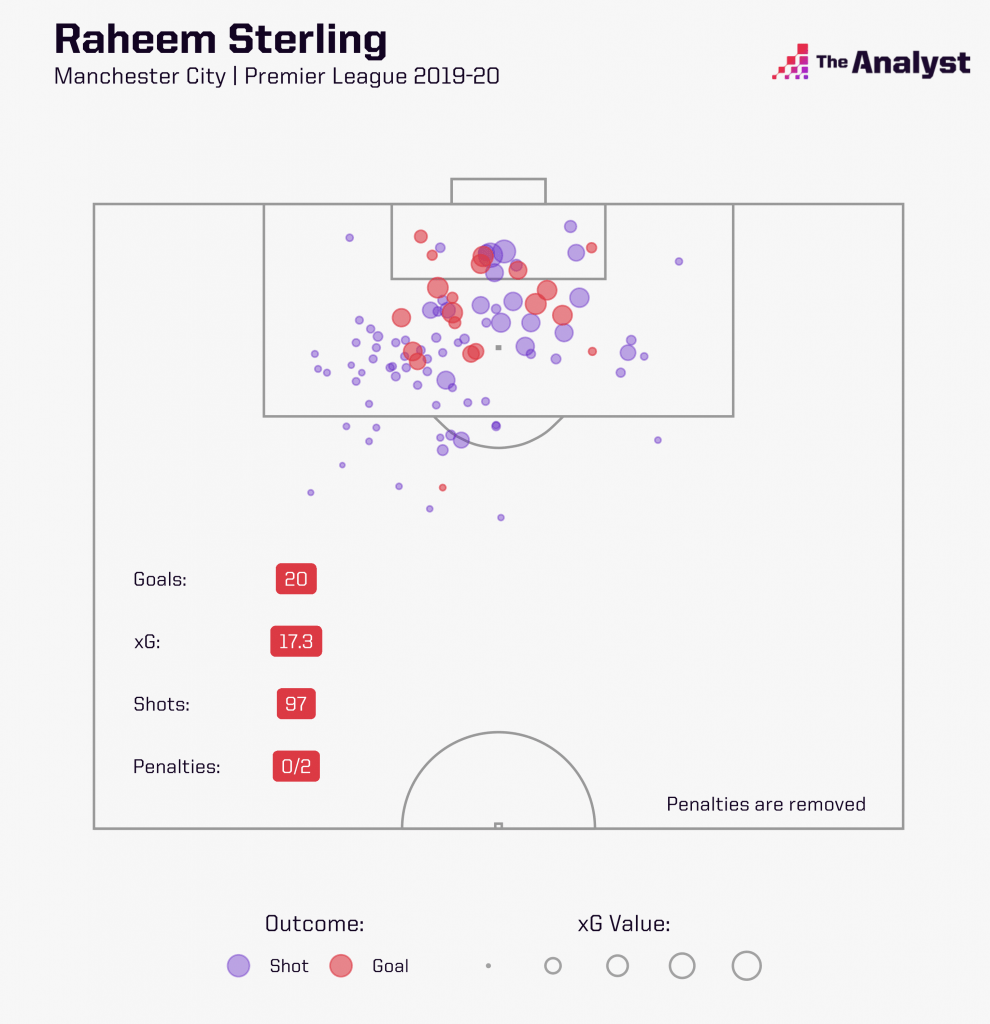
The Art of the Tap-in Merchant
This is another criticism some detractors like to level at Sterling: that he is a “tap-in merchant”, who simply gorges on Guardiola’s feast of football to pad his stats from close range.
But, as Gary Lineker is often keen to point out with a heavy helping of self-deprecation, if it were that easy then everyone would be doing it.
If the misses outlined above suggest a shortfall in Sterling’s technique as a finisher, then his capacity to sniff out chances through intelligent and clinical movements stand as one of his main assets.
Throughout his City career, his shots-per-game average has ranged from between 2.3 to 3.3 when split by season. However, his expected goals (xG) figure per 90 minutes increased significantly in those three most prolific campaigns.
In 2017-18, his xG/90 was 0.56, set against 0.21 for Leroy Sane, City’s other first-choice winger that year. Sane and Sterling had near-identical xG/90 scores of 0.28 and 0.27 during the previous season, Guardiola’s first at the helm.
Despite averaging slightly more shots per game than Sterling in 2019-20 (3.4 to 3.3), Riyad Mahrez’s xG/90 was 0.36 compared to his team-mate’s 0.64.
This shows Sterling getting himself into notably better scoring areas, with a greater probability of finding the net, than team-mates playing in the same position. Even considering the fact Mahrez appears to have usurped Sterling in Guardiola’s pecking order for now, his xG/90 is still half that of the England man in 2020-21 (0.21 vs 0.42).
If this suggests a notable tenacity and relentlessness around the opposition penalty area, Sterling’s dribbling ability and productivity when carrying possession underlines the point.
Guardiola values forwards who can bring an unpredictable element to the possession-dominating foundations of his sides and Sterling certainly excels here, showing himself to be one of the most adept players in the division when it comes to running with the ball and making something happen.
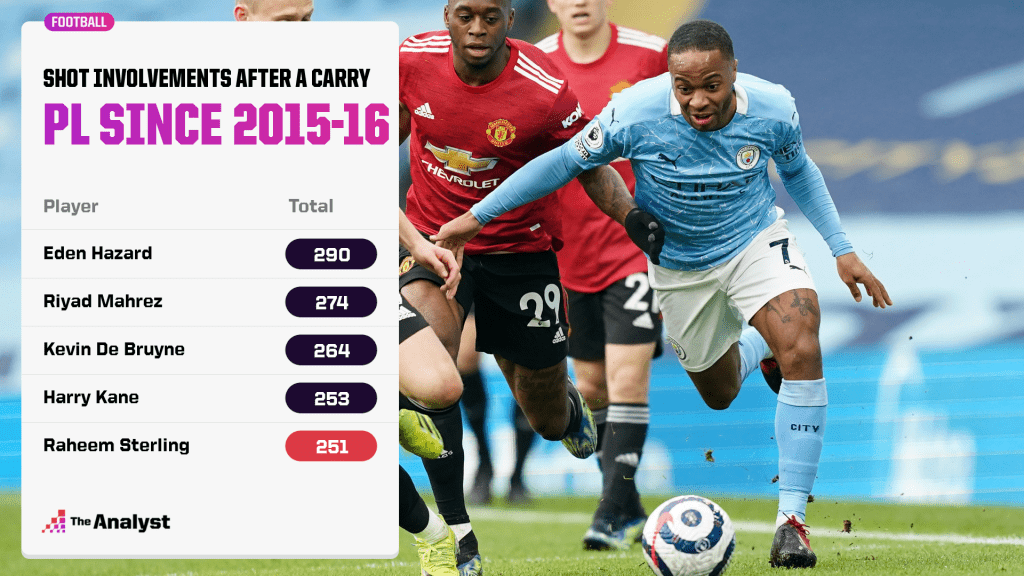
Since joining City in 2015-16, Sterling is ranked fifth (251) in the Premier League for shot involvements after a ball carry – meaning he has either had a shot himself or set up a team-mate to do so after travelling with the ball for five metres or more.
As with his output in front of goal, Sterling’s figures for carries and progressive carries are down this term, but a return to those levels seems comfortably within reach for a player of his age and ability.
At the risk of just loudly shouting, “KICK IT AT THE GOAL, RAHEEM!”, he could also shoot more. An uneven return to the starting XI in Saturday’s FA Cup win at Everton yielded four attempts on goal, a couple of them fairly wild.
That was up on his season average of 2.3 attempts per 90 minutes. And, if awful misses from close quarters is one of Sterling’s main regrettable habits, taking too many touches and checking inside to be crowded out by defenders is another.
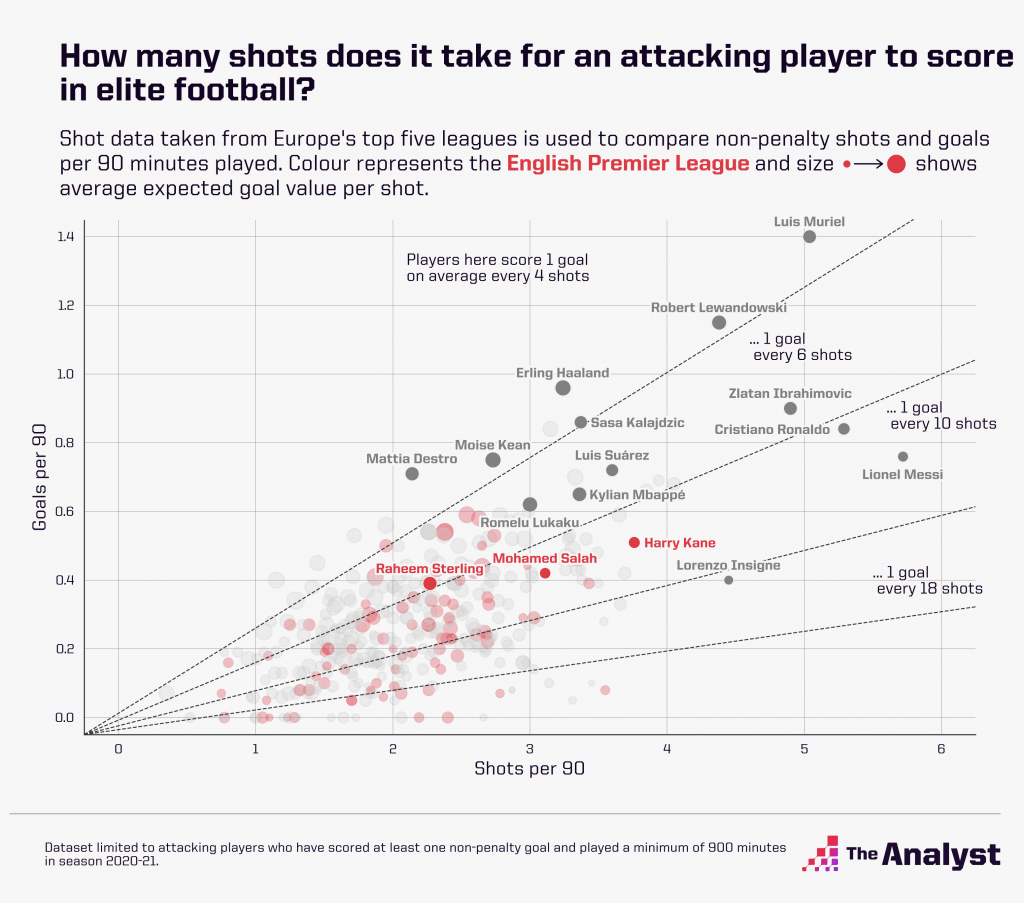
Cristiano Ronaldo and Lionel Messi average above five attempts per match. Obviously, there is a lot more to their majestic careers than just shooting a lot, but their continually handsome hauls show the value of a star forward backing themselves.
It feels like a relatively minor tweak that could take Sterling’s game to the next level, when considering all his other demonstrable qualities.
A provocative newspaper interview with Marca last season, where he posed with a Real Madrid shirt, showed a man who thinks he belongs on the A-list and the returns of a nine-year Premier League career back that up. Being only the third player to score 100 goals under Guardiola after Messi and Aguero isn’t bad, either.
With everything again possible for City on the other side of the international break, Sterling has the perfect platform to put a tricky couple of weeks behind him and step it up once more.
Design by Matt Sisneros.
